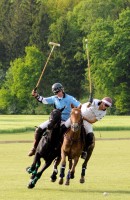Discrete, fast and with years of market knowledge.
 Often known as the 'sport of kings,' polo can trace its history back even further than most of the influential aristocrats who now play the sport. Its origins are thought to lie somewhere around the 6th century BC - initially a training game for soldiers on horseback, it soon became a national sport widely celebrated in ancient Persian literature. Although polo soon spread successfully across much of Asia and the Middle East, it was in India that the game was first introduced to Europe.
Often known as the 'sport of kings,' polo can trace its history back even further than most of the influential aristocrats who now play the sport. Its origins are thought to lie somewhere around the 6th century BC - initially a training game for soldiers on horseback, it soon became a national sport widely celebrated in ancient Persian literature. Although polo soon spread successfully across much of Asia and the Middle East, it was in India that the game was first introduced to Europe.
The north-eastern state of Manipur boasts the oldest polo ground in the world, and is also the place where British colonists first saw the game being played and promptly 'borrowed' it. The first modern polo club was founded in Assam in 1834 and the game has since been exported all around the world. It's now played officially by 77 countries - 16 professionally - with Argentina boasting the largest number of players to ever achieve ten-goal handicap status. Other hotspots for polo include Australia, New Zealand, South Africa, China, Dubai, Spain and Chile.
In Europe, the season starts in late April and runs to late September. In the southern hemisphere, the season stretches from October to the middle of March, although in some places including Australia, South Africa and the USA, the sport is played throughout the year. Recent years have also seen polo taken up in cooler climates, with Switzerland's St. Moritz Polo Club holding tournaments in the snow since 1983 and international 'snow polo' matches taking place in Russia and China.
The costs associated with any sport involving horses have helped to preserve polo's status as an elite sport, with royals and aristocrats some of the game's most prominent modern players. However, most polo games welcome spectators, with many of the world's smaller clubs operating a free entry policy to matches. In field polo, the pitch is a grass area of up to 300 yards long and 160 yards wide, making it the largest playing field in organised sport. A team consists of four riders and their mounts, with men and women playing on the same teams. A modern game is around an hour and a half long, divided into seven-minute periods called chukkers, between which the players must change horses.
Like most popular sports, the rules of polo are not complicated by themselves, but extensive training, determination and athleticism are required in order to become a skilful player. The main objective is to score goals from horseback by hitting a small white plastic ball into the goal of the opposing side. In addition to being excellent horse-riders, players need to have an expert grasp of tactics to avoid accidental fouls that result in penalties.
Professional players are ranked on an annual basis; with the number of goals they've scored used to place them between -2 and 10. Teams are then handicapped on the basis of their players' rankings. At the Engel & Völkers 2013 Polo Cup there were several teams with +5 or +6 handicaps, resulting in several fiercely competitive and thrilling matches.
The Engel & Völkers Polo Schools in Hamburg, Berlin and Mallorca help to train future professional players, offering everything from beginners' courses to intensive training. Visit our official website to learn more about the sport of kings.
The Engel & Völkers Polo Cup - get information here: www.engelvoelkers.com/polocup